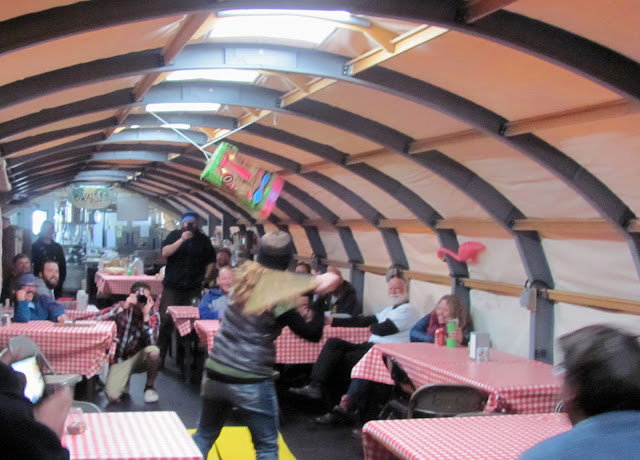This field camp supports a project coring ice of the West Antarctic Ice Sheet (WAIS). January 2012, they completed the project, going over 3,400 meters deep. Over two miles. It's estimated that the cores reach back 68,000 years, giving researchers a record of weather and climate. That's the principle goal of the project. This year they went back and replicated some cores that were of special interest.
The camp started the summer season of 2005-06. Since then, it's been staffed and operating from whenever they can put in, usually sometime in November, until late January or early February. The camp population was in the 40's and 50's but occasionally swelled even more. Many people came through on other science projects or on their way to somewhere else. I passed through on my way to and from PIG. Lots folks have been WAIS'd.
 |
| The other side of town starts at the long recreation tent with a wash mod on back. Inside the tent was an exercise bike, couches, computer stations and a large scale flat screen for movies. The wash mod had a snow melter, water heater, washer, dryer, three sinks and two showers. Hot and cold running water! Beyond that is the medical tent, staffed by a physician's assistant. The next two tents were berthing for the flight crews. At the end is a Jamesway for transient berthing. |
 |
| And in the center of town, the center of many activities, the Galley. Who knows how the flamingos got there or when. |
 | ||
|
 |
| Speaking of talented people, the second Saturday I was in town, there was an open-mike, coffee house in the rec tent. There were several very good readings of original work, some live music and even a couple limericks that I won't repeat here. The pilot that recited them swore her old Irish grandmother taught them to her. |
 |
It wasn't all fun and games. This is one of the crews headed out for a shift in the arch. I believe they worked two shifts a day, six days a week.  With all that hard work, the crews finished their work ahead of schedule. The final Saturday most of us were in town, we had a party to celebrate. One of the researchers brought a pinata along for just such an occasion. It was full of liquor miniatures. Seems to be a trend here. |
While the folks were out at the arch working and other researchers were out putting in weather and seismic stations and whatever, there was a camp staff keeping things going. Besides the cooks, there were two mechanics, two equipment operators, two weather observers, a fuels person, a person responsible for communications and IT, one camp coordinator, one camp manager and an electrician.
When this project was funded, it was decided that there would be an electrician at camp at all times. I'm not sure why. There is a lot of equipment in the arch, but those folks pretty much took care of things. Most of my time was spent helping the other people in camp, shoveling snow, loading cargo, shoveling snow, loading the snow melters, shoveling snow. I looked for electrical work to do.
 |
| Sometimes I looked for work. Sometimes I didn't. |
At the end of my three weeks, it was time for the camp to close. I started the process and the same electrician that put up camp came out to finish the take-out, as they call it.
Once again, I had a ball. I've even asked to go out next year for another three week shift. Yeah, that's right, I'll be back here again next year.
But right now it's time to go. The winter crew has been showing up for a few weeks. The fuel ship has been here and gone, the cargo ship has been unloaded and is being reloaded with waste. Most of the scientists and researchers are gone. The ski-equipped C-130 planes are all back in New Zealand, getting ready to head north.
I'm scheduled to fly out Feb. 24 weather permitting. I'm going to spend a few days in Christchurch getting my physical completed as much as possible for next season. The company arranges it so I won't have to pay anything. After that I'm headed back to Bali for a few days of diving on Nusa Lembongan. Then it's over to another Indonesian island called Lombok. I'm told it's one of the most relaxing places in the world. I intend to find out.
In mid-March I'll be back in Pennsylvania.
See you whenever.












